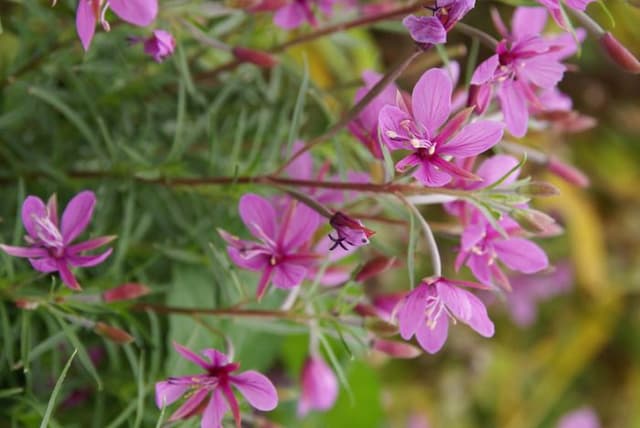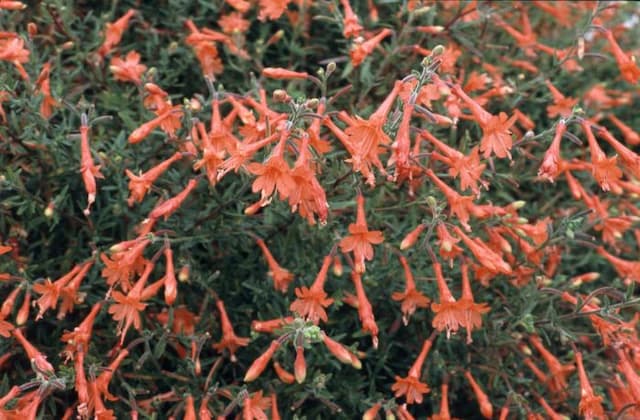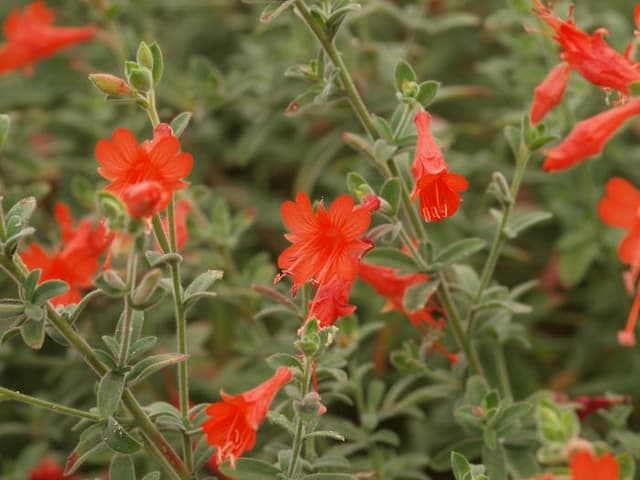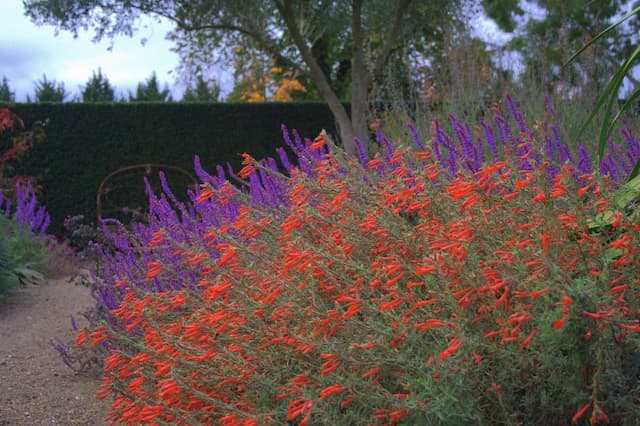Blue Angel Fuchsia Fuchsia 'Blauer Engel' (d)

ABOUT
Fuchsia 'Blauer Engel', also known as Blue Angel, is a strikingly beautiful plant noted for its unique and decorative flowers. The blossoms hang from the stems like dainty earrings, characterized by a two-toned color palette. The outer parts of the flowers are typically a deep purple or magenta, forming a long, tubular shape. Enclosed within this tube are the inner petals which are often a vibrant, contrasting shade of violet or pink. These inner petals flare out at the bottom of the tube like a skirt. The flowers of the Blue Angel Fuchsia have long, slender sepals that extend upwards, which may be the same color as the tube or have a hint of green. Prominent stamens extend from the center of each flower, adding to their ornamental quality. These blossoms are a point of attraction for hummingbirds and other pollinators. Fuchsia 'Blauer Engel' displays rich green foliage that forms a lush background to the vivid floral display. The leaves are oval-shaped with a slightly serrated edge and are arranged opposite each other along the stems. The overall result is a stunning display of contrasting colors that stand out in a garden setting or when grown as a potted plant. The soft cascade of flowers and the graceful arching growth habit give this plant an elegant appearance.
About this plant
 Names
NamesFamily
Onagraceae
Synonyms
Blue Angel Fuchsia, Hardy Fuchsia
Common names
Fuchsia 'Blauer Engel'
 Toxicity
ToxicityTo humans
Fuchsia 'Blauer Engel', commonly known as Fuchsia, is not considered toxic to humans. Generally, fuchsias are regarded as safe when touched and non-toxic if ingested. There are no significant symptoms of poisoning associated with fuchsias, as they do not contain substances known to be harmful to humans. However, as with any non-food plant, individual allergic reactions or sensitivities are possible, and ingestion of any plant material could potentially cause mild stomach upset in some people.
To pets
Fuchsia 'Blauer Engel', commonly known as Fuchsia, is also not toxic to pets. Fuchsias are generally safe for animals, and there should be no symptoms of poisoning if pets ingest parts of the plant. It is always possible for pets to experience some gastrointestinal discomfort from eating non-food items, but the fuchsia plant itself does not contain toxins that are known to cause serious harm or illness to animals.
 Characteristics
CharacteristicsLife cycle
Perennials
Foliage type
Deciduous
Color of leaves
Green
Flower color
Mixed
Height
1-2 feet (30-60 cm)
Spread
1-2 feet (30-60 cm)
Plant type
Shrub
Hardiness zones
9
Native area
Central and South America
Benefits
 General Benefits
General Benefits- Attractive Flowers: Fuchsia 'Blauer Engel' produces vibrant, pendulous flowers that are highly decorative and add aesthetic value to gardens and outdoor spaces.
- Pollinator Friendly: This plant attracts hummingbirds, bees, and other pollinators, supporting biodiversity.
- Versatile Usage: It is suitable for container planting, hanging baskets, and as part of a mixed border, offering flexibility in garden design.
- Shade Tolerance: Fuchsias can thrive in partial shade, making them an excellent choice for garden spots that receive less sunlight.
- Long Blooming Period: Fuchsia 'Blauer Engel' has a long flowering season, providing color and interest from late spring to early fall.
 Medical Properties
Medical PropertiesThis plant is not used for medical purposes.
 Air-purifying Qualities
Air-purifying QualitiesThis plant is not specifically known for air purifying qualities.
 Other Uses
Other Uses- Fuchsia 'Blauer Engel' can be used as a natural dye for fabrics or art projects, deriving its color from the plant's vivid blossoms.
- Creating a visually attractive garnish on culinary dishes, especially desserts, due to its unique flower shape and color. Always ensure flowers are pesticide-free before consumption.
- Incorporating the fuchsia into bonsai art for a stunning and colorful miniature tree that brings an exotic flair to the collection.
- Using dried fuchsia flowers to make bookmarks or pressed flower art, preserving their beauty in a different form.
- Fuchsia petal-infused water can add a subtle scent and color to homemade natural cosmetics or bath products.
- Plant parts can be used in potpourris for household fragrance, often combined with other aromatic herbs and flowers.
- Employing the Fuchsia in fairy gardens or miniature landscapes as they lend a magical and whimsical aspect with their lantern-like flowers.
- As a floral arrangement or corsage for special events, fuchsia flowers add a splash of color and uniqueness to the ensemble.
- The plant can be used in crafting, such as creating natural, plant-based jewelry like earrings, where the flowers serve as the centerpiece.
- Used in educational settings, such as schools or botanical gardens, to teach about plant structure and pollination, since fuchsias have distinct and instructive flower formations.
Interesting Facts
 Feng Shui
Feng ShuiThe Fuchsia is not used in Feng Shui practice.
 Zodiac Sign Compitability
Zodiac Sign CompitabilityThe Fuchsia is not used in astrology practice.
 Plant Symbolism
Plant Symbolism- Grace – The elegant drooping flowers of the fuchsia symbolize grace and subtlety in the language of plants.
- Good taste – Fuchsia's distinctive blooms are associated with a refined sensibility and personal preference for quality and aesthetics.
- Confiding love – The fuchsia has been known to convey deep trust and confidence within a loving relationship.
- Mystique – Its unique flowers with a combination of two colors often symbolize a sense of deep mystery and enchantment.
 Water
WaterFuchsias, including the 'Blue Angel', prefer consistently moist soil, so watering should be done when the top inch of soil feels dry to the touch. Typically, this means watering once or twice a week, but frequency can increase during hot, dry periods or if the plant is in a container. Each watering session should provide enough water to saturate the soil without causing waterlogging. For a medium-sized fuchsia in a pot, this could be around 16 to 32 ounces of water, depending on pot size and environmental conditions.
 Light
LightThe 'Blue Angel' Fuchsia flourishes in bright, indirect light. It is best placed in a location where it will receive morning sun and shaded from the intense afternoon rays to prevent leaf burn. A north-facing or east-facing spot would be ideal for this plant to ensure it gets the right balance of light without direct sun exposure at the hottest part of the day.
 Temperature
TemperatureFuchsias like 'Blue Angel' thrive in cool to warm conditions with temperatures ideally between 55 and 75 degrees Fahrenheit. They are sensitive to extreme heat and cold, and should be protected if temperatures are expected to exceed 85 degrees or drop below 40 degrees. The ideal temperature range ensures healthy growth and abundant blooming.
 Pruning
PruningPruning the 'Blue Angel' Fuchsia improves air circulation, encourages a bushier growth habit, and promotes more flowers. Prune in late winter or early spring, removing dead or weak branches and shortening long shoots to maintain a compact form. Pruning can be done again lightly after the initial flush of flowers to encourage a second bloom. It's best to prune annually, or as needed to shape the plant and remove any dead material.
 Cleaning
CleaningAs needed
 Soil
SoilThe Hardy Fuchsia prefers a fertile, well-draining soil mix, with a slightly acidic to neutral pH around 6.0 to 7.0. A good mix would be one part peat moss, one part loam, and one part perlite or sand to facilitate drainage.
 Repotting
RepottingHardy Fuchsias should be repotted every two to three years or when they become root-bound. It's best to repot in late winter or early spring before new growth begins.
 Humidity & Misting
Humidity & MistingHardy Fuchsias thrive in moderate to high humidity levels, around 60-70%. They benefit from a humid environment but can tolerate lower humidity levels if necessary.
 Suitable locations
Suitable locationsIndoor
Keep in bright, indirect light and ensure good air circulation.
Outdoor
Place in partial shade; shelter from strong winds.
Hardiness zone
6-9 USDA
 Life cycle
Life cycleThe Fuchsia 'Blauer Engel', commonly known as the Hardy Fuchsia, begins its life cycle when seeds germinate or cuttings take root in moist, well-drained soil, typically in spring. Seedlings emerge and develop into young plants, setting out leaves and establishing a root system. As the plant matures, it goes through a period of vegetative growth, producing distinctive bushy foliage and stems. During the flowering stage, which occurs from late spring through fall, 'Blauer Engel' produces pendulous, tubular flowers that are predominantly purple and pink. After pollination, often by hummingbirds or other pollinators, the flowers develop into small, dark fruit. The plant then enters a period of dormancy in winter, especially in cooler climates, where it may die back and require protective mulching or removal from the ground until the next growing season.
 Propogation
PropogationPropogation time
Spring-Early Summer
The Fuchsia 'Blauer Engel', commonly known as the Blue Angel Fuchsia, can be propagated through the method of stem cuttings, which is particularly popular among gardeners. This method is often carried out in late spring to early summer when the plant is actively growing. To propagate by cuttings, a gardener takes a healthy, non-flowering shoot, ideally about 2 to 4 inches (approximately 5 to 10 centimeters) long, making sure the cut is just below a leaf node. The lower leaves are then removed, and the stem is dipped in rooting hormone to encourage root development. This cutting is then placed in a well-draining potting mix, ensuring at least one node where the leaves were removed is buried beneath the soil surface. The cutting should be kept moist and placed in indirect light until it has rooted, which typically takes several weeks. Once the new Fuchsia 'Blauer Engel' has established a sufficient root system, it can be transplanted into its final location.









